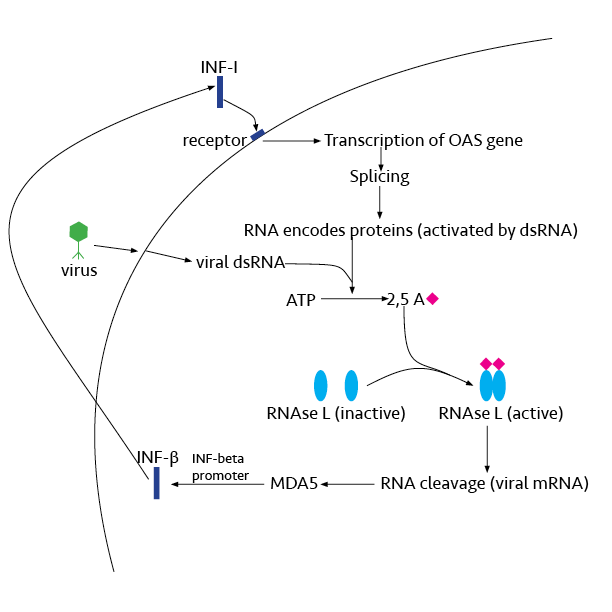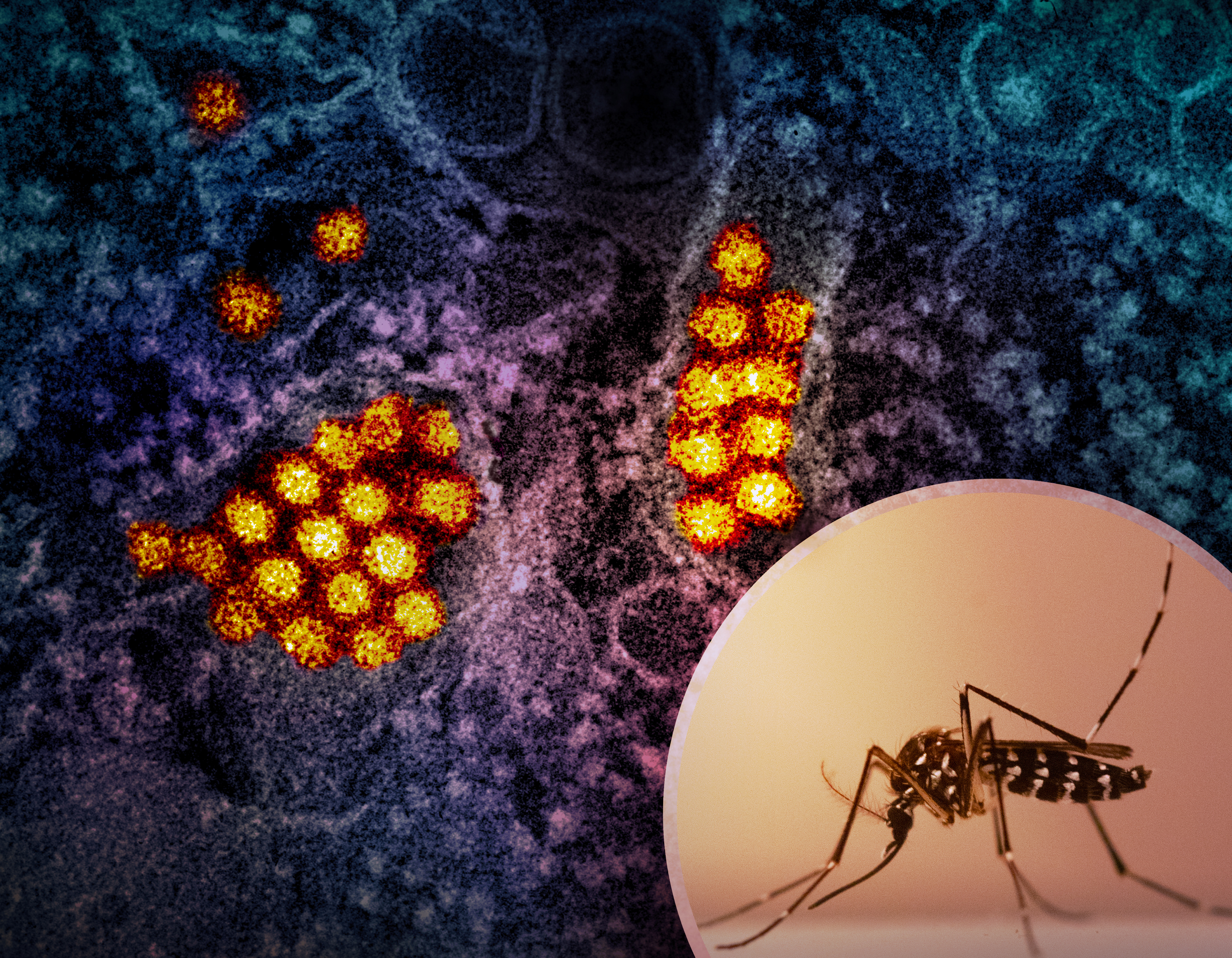|
Antiviral Protein
Antiviral proteins are proteins that are induced by human or animal cells to interfere with viral replication. These proteins are isolated to inhibit the virus from replicating in a host's cells and stop it from spreading to other cells. The Pokeweed antiviral protein and the Zinc-Finger antiviral protein are two major antiviral proteins that have undergone several tests for viruses, including HIV and influenza. Pokeweed antiviral protein Pokeweed antiviral protein is a ribosome inactivating protein that provides pokeweed plants protection against both viral and fungal infections. It also protects other types of plants that have genetically engineered to express RAP that do not normally do so. Recombinant pokeweed antiviral protein has also been proposed as a treatment of human diseases such as AIDS and cancer. ZC3HAV1 ZAP (Zinc finger Antiviral Protein) is encoded by the ZC3HAV1 gene in humans whose expression is induced by interferon and helps fight a number of viral i ... [...More Info...] [...Related Items...] OR: [Wikipedia] [Google] [Baidu] |
1-s2
1S or 1s may refer to: * 1s electron, in an atomic orbital * Sabre (computer system)'s IATA code * 1S, a series of Toyota S engines * SSH 1S (WA); see Washington State Route 502, Washington State Route 503 * One shilling (British coin) See also *Shilling The shilling is a historical coin, and the name of a unit of modern currency, currencies formerly used in the United Kingdom, Australia, New Zealand, other British Commonwealth countries and Ireland, where they were generally equivalent to 1 ... * Second * Ones (other) * S1 (other) {{Letter-NumberCombDisambig ... [...More Info...] [...Related Items...] OR: [Wikipedia] [Google] [Baidu] |
Ribonuclease L
Ribonuclease L or RNase L (for ''latent''), known sometimes as ribonuclease 4 or 2'-5' oligoadenylate synthetase-dependent ribonuclease, is an interferon (IFN)-induced ribonuclease which, upon activation, destroys all RNA within the cell (both cellular and viral) as well as inhibiting mRNA export. RNase L is an enzyme that in humans is encoded by the ''RNASEL'' gene. This gene encodes a component of the interferon-regulated 2'-5'oligoadenylate (2'-5'A) system that functions in the antiviral and antiproliferative roles of interferons. RNase L is activated by dimerization, which occurs upon 2'-5'A binding, and results in cleavage of all RNA in the cell. This can lead to activation of MDA5, an RNA helicase involved in the production of interferons. Synthesis and activation RNase L is present in very minute quantities during the normal cell cycle. When interferon binds to cell receptors, it activates transcription of around 300 genes to bring about the antiviral state. Among ... [...More Info...] [...Related Items...] OR: [Wikipedia] [Google] [Baidu] |
Double-stranded RNA
Double-stranded RNA (dsRNA) is RNA with two complementary strands found in cells. It is similar to DNA but with the replacement of thymine by uracil and the adding of one oxygen atom. Despite the structural similarities, much less is known about dsRNA. They form the genetic material of some viruses ( double-stranded RNA viruses). dsRNA, such as viral RNA or siRNA, can trigger RNA interference in eukaryotes, as well as interferon response in vertebrates. In eukaryotes, dsRNA plays a role in the activation of the innate immune system against viral infections. History of discovery Watson and Crick had noted early on that the 2′ hydroxyl group on each RNA nucleotide would prevent RNA from forming a double helix similar to the one they had described for DNA. In 1995, Alexander Rich Alexander Rich (15 November 1924 – 27 April 2015) was an American biologist and biophysicist. He was the William Thompson Sedgwick Professor of Biophysics at MIT (since 1958) and Harvard ... [...More Info...] [...Related Items...] OR: [Wikipedia] [Google] [Baidu] |
Protein Kinase R
Protein kinase RNA-activated also known as protein kinase R (PKR), interferon-induced, double-stranded RNA-activated protein kinase, or eukaryotic translation initiation factor 2-alpha kinase 2 (EIF2AK2) is an enzyme that in humans is encoded by the ''EIF2AK2'' gene on chromosome 2. PKR is a serine/tyrosine kinase that is 551 amino acids long. PKR is inducible by various mechanisms of stress and protects against viral infections. It also has a role in several signaling pathways. Mechanism of action Protein kinase-R is activated by double-stranded RNA (dsRNA), introduced to the cells by a viral infection. In situations of viral infection, the dsRNA created by viral replication and gene expression binds to the N-terminal domain, activating the protein. PKR activation via dsRNA is length dependent, requiring the dsRNA to be 30 bp in length to bind to PKR molecules. However, excess dsRNA can diminish activation of PKR. Binding to dsRNA is believed to activate PKR by inducing d ... [...More Info...] [...Related Items...] OR: [Wikipedia] [Google] [Baidu] |
Dengue Virus
Dengue virus (DENV) is the cause of dengue fever. It is a mosquito-borne, single positive-stranded RNA virus of the family ''Flaviviridae''; genus '' Flavivirus''. Four serotypes of the virus have been found, and a reported fifth has yet to be confirmed,Dwivedi, V. D., Tripathi, I. P., Tripathi, R. C., Bharadwaj, S., & Mishra, S. K. (2017). Genomics, proteomics and evolution of ''Dengue virus''. Briefings in functional genomics.16(4): 217–227, https://doi.org/10.1093/bfgp/elw040 all of which can cause the full spectrum of disease. Nevertheless, the mainstream scientific community's understanding of dengue virus may be simplistic as, rather than distinct antigenic groups, a continuum appears to exist. This same study identified 47 strains of ''dengue virus''. Additionally, coinfection with and lack of rapid tests for Zika virus and chikungunya complicate matters in real-world infections. ''Dengue virus'' has increased dramatically within the last 20 years, becoming one of the ... [...More Info...] [...Related Items...] OR: [Wikipedia] [Google] [Baidu] |
Ebolavirus
The genus ''Ebolavirus'' (- or ; - or ) is a International Committee on Taxonomy of Viruses, virological taxon included in the family ''Filoviridae'' (filament-shaped viruses), order ''Mononegavirales''. The members of this genus are called ebolaviruses, and encode their genome in the form of RNA virus#Group V—negative-sense ssRNA viruses, single-stranded negative-sense RNA. The six known virus International Committee on Taxonomy of Viruses, species are named for the region where each was originally identified: ''Bundibugyo ebolavirus'', ''Reston ebolavirus'', ''Sudan ebolavirus'', ''Taï Forest ebolavirus'' (originally ''Côte d'Ivoire ebolavirus''), ''Zaire ebolavirus'', and ''Bombali ebolavirus''. The last is the most recent species to be named and was isolated from Angolan free-tailed bats in Sierra Leone. Each species of the genus ''Ebolavirus'' has one member virus, and four of these cause Ebola virus disease (EVD) in humans, a type of Viral hemorrhagic fever, hemorrhagic ... [...More Info...] [...Related Items...] OR: [Wikipedia] [Google] [Baidu] |
Influenza A Virus
''Influenza A virus'' (''Alphainfluenzavirus influenzae'') or IAV is the only species of the genus ''Alphainfluenzavirus'' of the virus family '' Orthomyxoviridae''. It is a pathogen with strains that infect birds and some mammals, as well as causing seasonal flu in humans. Mammals in which different strains of IAV circulate with sustained transmission are bats, pigs, horses and dogs; other mammals can occasionally become infected. IAV is an enveloped negative-sense RNA virus, with a segmented genome. Through a combination of mutation and genetic reassortment the virus can evolve to acquire new characteristics, enabling it to evade host immunity and occasionally to jump from one species of host to another. Subtypes of IAV are defined by the combination of the antigenic H and N proteins in the viral envelope; for example, "H1N1" designates an IAV subtype that has a type-1 hemagglutinin (H) protein and a type-1 neuraminidase (N) protein. Almost all possible combinations of H ... [...More Info...] [...Related Items...] OR: [Wikipedia] [Google] [Baidu] |
Gene
In biology, the word gene has two meanings. The Mendelian gene is a basic unit of heredity. The molecular gene is a sequence of nucleotides in DNA that is transcribed to produce a functional RNA. There are two types of molecular genes: protein-coding genes and non-coding genes. During gene expression (the synthesis of Gene product, RNA or protein from a gene), DNA is first transcription (biology), copied into RNA. RNA can be non-coding RNA, directly functional or be the intermediate protein biosynthesis, template for the synthesis of a protein. The transmission of genes to an organism's offspring, is the basis of the inheritance of phenotypic traits from one generation to the next. These genes make up different DNA sequences, together called a genotype, that is specific to every given individual, within the gene pool of the population (biology), population of a given species. The genotype, along with environmental and developmental factors, ultimately determines the phenotype ... [...More Info...] [...Related Items...] OR: [Wikipedia] [Google] [Baidu] |
Enzyme
An enzyme () is a protein that acts as a biological catalyst by accelerating chemical reactions. The molecules upon which enzymes may act are called substrate (chemistry), substrates, and the enzyme converts the substrates into different molecules known as product (chemistry), products. Almost all metabolism, metabolic processes in the cell (biology), cell need enzyme catalysis in order to occur at rates fast enough to sustain life. Metabolic pathways depend upon enzymes to catalyze individual steps. The study of enzymes is called ''enzymology'' and the field of pseudoenzyme, pseudoenzyme analysis recognizes that during evolution, some enzymes have lost the ability to carry out biological catalysis, which is often reflected in their amino acid sequences and unusual 'pseudocatalytic' properties. Enzymes are known to catalyze more than 5,000 biochemical reaction types. Other biocatalysts include Ribozyme, catalytic RNA molecules, also called ribozymes. They are sometimes descr ... [...More Info...] [...Related Items...] OR: [Wikipedia] [Google] [Baidu] |
Ribonuclease
Ribonuclease (commonly abbreviated RNase) is a type of nuclease that catalyzes the degradation of RNA into smaller components. Ribonucleases can be divided into endoribonucleases and exoribonucleases, and comprise several sub-classes within the EC 2.7 (for the phosphorolytic enzymes) and 3.1 (for the hydrolytic enzymes) classes of enzymes. Function All organisms studied contain many RNases of two different classes, showing that RNA degradation is a very ancient and important process. As well as clearing of cellular RNA that is no longer required, RNases play key roles in the maturation of all RNA molecules, both messenger RNAs that carry genetic material for making proteins and non-coding RNAs that function in varied cellular processes. In addition, active RNA degradation systems are the first defense against RNA viruses and provide the underlying machinery for more advanced cellular immune strategies such as RNAi. Some cells also secrete copious quantities of non-specific ... [...More Info...] [...Related Items...] OR: [Wikipedia] [Google] [Baidu] |
Interferon Type I
The type-I interferons (IFN) are cytokines which play essential roles in inflammation, immunoregulation, tumor cells recognition, and T-cell responses. In the human genome, a cluster of thirteen functional IFN genes is located at the 9p21.3 cytoband over approximately 400 kb including coding genes for IFNα (''IFNA1, IFNA2, IFNA4, IFNA5, IFNA6, IFNA7, IFNA8, IFNA10, IFNA13, IFNA14, IFNA16, IFNA17'' and ''IFNA21''), IFNω (''IFNW1''), IFNɛ (''IFNE''), IFNк (''IFNK'') and IFNβ (''IFNB1''), plus 11 IFN pseudogenes. Interferons bind to interferon receptors. All type I IFNs bind to a specific cell surface receptor complex known as the IFN-α receptor ( IFNAR) that consists of IFNAR1 and IFNAR2 chains. Type I IFNs are found in all mammals, and homologous (similar) molecules have been found in birds, reptiles, amphibians and fish species. Sources and functions IFN-α and IFN-β are secreted by many cell types including lymphocytes ( NK cells, B-cells and T-cells), macropha ... [...More Info...] [...Related Items...] OR: [Wikipedia] [Google] [Baidu] |





